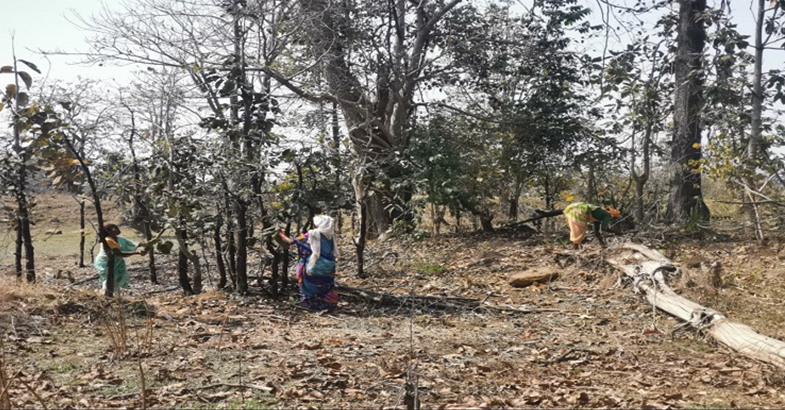
Tribal women working in the forest of Neharpayli village, Gadchiroli district, Maharashtra, March 2022. Photo courtesy: Author
This blog opines that the Indian state’s failure to secure gender equality in India’s forest governance, despite legal instruments like the 1992 73rd Amendment, the 1996 Panchayats Extension to Scheduled Areas (PESA), and the 2006 Forest Rights Act (FRA).
Tribal women encounter gender inequality often during forest governance in India. Their participation in India’s forest governance discourse is not argued very strongly, as there is a knowledge gap in the scientific literature concerning tribal women’s access to forestland and forest resources. In general, gender inequality is ubiquitous in Indian society due to the hegemony of patriarchy. However, tribal communities are historically more gender inclusive.
The analysis is based on his fieldwork experience in the Gadchiroli district of Maharashtra, India. Gadchiroli is a densely tribal populated fifth scheduled area. The district’s total population is 10,72,942, and 4,15,306 are tribals, also known as scheduled tribes (STs). ST category was coined during the British Empire and was later adopted by the framers of the Constitution of India as a constitutional category.
In India, tribal regions are divided into fifth and sixth scheduled areas from a governance point of view. Tribal women are among the disadvantaged and socio-economically backward gender due to existing gender bias within households and communities.
Indian Laws to Mitigate Gender Inequality
The Fifth schedule of Article 244 (1) of the Indian Constitution has provisions related to the administration and control of scheduled areas except for Northeast states. In the fifth schedule, the President of India can declare specific or entire parts to be scheduled areas. However, no specific provisions in the Constitution of India explicitly state the classification of criteria to be scheduled areas. The reasonable size of the area, backwardness nature, and socioeconomic disparity of the people has been commonly accepted as a benchmark to be scheduled area. The Governor has special powers to intervene in any matter of the fifth scheduled areas.
Scheduled areas have distinct governance mechanisms from the rest of the country. However, tribal women’s political representation and political involvement are very limited in scheduled areas. In other words, their political situation is not different from those of women in the mainstream patriarchal society. Despite the 73rd Amendment and the PESA enactment, the Indian state has failed to mitigate gender inequality in the decision-making process of Gram Panchayat (GP), a local village governance body.
The Indian state tried to ensure tribal women’s representation in forest governance by passing the FRA. PESA and FRA work to bolster women’s inclusion by ensuring their participation in village and forest governance. However, women’s participation in the decision-making process still needs to be improved.
The FRA implementation has paved the path for tribal women to claim their ownership rights over the forest and its forest produces. Tribal women’s political representation and political involvement are regulated by their counterparts. However, they keep resisting gender inequality in day-to-day activities.
What is Forest Governance?
In the fifth scheduled area, forest governance at the village level is an institutional set-up which provides equal opportunity to both tribal women and men to manage and influence multiple micro-policy processes of committees. These committees are formed under the direction of the 73rd Amendment and PESA (Gram Panchayats- the elected government administrative body of one or more villages), the 2006 Forest Rights Act (FRA), the Joint Forest Management Committees (JFMC) and customary rules.
Forest governance involves inter-institutional engagement within the designed policy instruments among stakeholders. It is a dynamic and evolving process; therefore, conceptualising forest governance is challenging. The politics of the forest department, the colonial mindset, and the tag of the left-wing extremist area have multiple kinds of influence over the tribal women’s access to the forest in the Gadchiroli district.
To reduce gender inequality, the conceptualisation of forest governance by policymakers, bureaucrats and state officials must embrace gender as a critical factor. Gender inequality impacts the lives and livelihood of individual women and even makes achieving global hunger, poverty and justice goals more challenging.
Gender Equality in Forest Governance
Gender equality is not only a human right. It is imperative to reduce the gender gap in forest governance. By reducing the gender gap in forest governance, tribal women’s life can be improved in many folds by giving them more space in the decision-making process related to natural resource management.
Earlier, tribal forest management was a women’s domain for producing sustenance. Thus, it evolved after British intrusion. Since the British Empire was interested in the commercial aspect of the forest, tribal knowledge became redundant and later was replaced by a masculinist science of forestry.
After the decentralisation of forest governance, both tribal women and men are equally responsible for the management and conservation of the forests. But tribal women are still responsible for fetching fuel and fodder.
Tribal Women and Everyday Drudgery
Mostly, tribal women spend their morning hours collecting forest produce, so they travel far into the forest. Hence, tribal women end up doing intensive labour in hot summers. However, women’s rights under the forest tenure reform are not recognised as a priority. On the other hand, tribal men’s forest tenure rights are considered to be more legitimate by state officials.
In addition, the minor forest produce, which is crucial for the livelihood of tribals, is mainly collected by the tribal women. Moreover, tribal women also do all the household chores, including informal labour in the agriculture field, in highly precarious conditions. However, women’s recognition as farmers in the formal or informal rural sector could be better.
Furthermore, their presence needs to be acknowledged as a farmer by the state. As a result, most of the welfare policies of farmers are designed in favour of men by default.
Tribal Women and Forest Rights
Tribal women are an essential part of the forest economy. Their recognition as a labour force is vital for gender equality and gender parity in income.
To improve the recognition of the women labour force, we must first ensure their representation in formal and informal governance mechanisms, which are the fulcrum of forest governance. PESA has provisions to reserve female representation in Gram Panchayats in the fifth scheduled areas.
Moreover, FRA and PESA influence the formal arrangement of forest governance in the Gadchiroli district. Forest governance is always a conflict in the mutual tussle between the forest administration and tribal society.
It still needs to be clarified who owns the forest and forest lands after enacting FRA. FRA has shown gender bias in assigning individual property rights. Such bias is a result of mainstream patriarchy. Therefore, tribal women face enormous challenges and backlash in the decision-making process of forest governance.
About the author:

Tejendra Pratap Gautam is a PhD scholar at the Ashank Desai Centre for Policy Studies, IIT Bombay. His doctoral research focuses on the 2006 Forest Rights Act (FRA) implementation process in the Gadchiroli district of Maharashtra, India. Tejendra’s research interests include public policy, forest rights and forest governance, subaltern politics, political ecology, degrowth and post-development.
DISCLAIMER : The views expressed in this blog/article are author’s personal.

